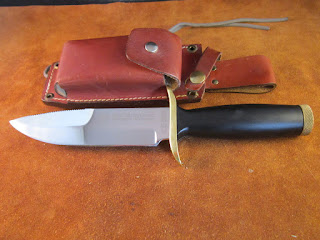1950's Cold War Nuclear Bomber Survival Knife!
Over half a century ago the United States Air Force was America's primary nuclear deterrent. This was accomplished by its long range bomber aircraft operated by the Strategic Air Command, the B-36, the B-47 and later on the B-52. ICBMs came along even later. To maintain razor sharp proficiency in the nuclear mission long range training missions were an daily occurrence and took airmen over every corner of the world. The Air Force became interested in refining its survival kits and equipment, particularly for arctic and alpine regions, as the fastest way to the targets in the Soviet Union was often over the polar route. Training missions sometimes turned into real life survival events.
In the late 1940's, General Curtis LeMay, the head of the Strategic Air Command (SAC), authorized the creation of a survival kit for the crews of the long range bombers. Requirements were to be an effective tool for survival in the wild, with the ability to perform a number of functions to include field dressing and cleaning fish. As part of that effort the Air Force in the early 1950s adopted a sheath knife for use in the E-1 Survival Kit. It was intended to be a tool, not a weapon, and weight was a major consideration. That knife was the Boker 155, a blade that is little known today among blade collectors.
The Boker had an overall length of 8 3/4", a 4 1/2" blade, a stacked leather handle, and aluminum guard and pommel. It was carried in a unique pouch or tube shaped leather sheath.
The birds head shaped pommel had a hole drilled through it to accommodate a thong to help the user avoid losing it. Both the knife and the sheath are free of any USAF or other military property markings. This has, no doubt, led to its anonymity among collectors. The left ricasso is simply marked "Boker U.S.A" and the right ricasso marked "155", the Boker model number.
Frank Trzaska relates how several knife models were evaluated for this role, including the famous Randall Model 14. All were rejected in favor of the little Boker. Some 300 of the Bokers were tested in the early 1950s at the USAF Survival School located at Stead AFB in Nevada. Total production numbers for the Boker 155 USAF Survival Knife are unknown. Other survival knives came along later which are better known and were produced in far greater numbers, including the Pilot Survival Knife and the 6" and 5" versions of the Jet Pilot Knife. Today, the little Boker remains a rarely seen and even more rarely recognized US military knife.
This design is similar to knives that were also being produced at that time by Case and Western referred to as Finn knives because of the close resembelence to knives being produced in Finland called Puukkos.
Today there is a resurgence in Bushcraft and extremely popular knives are the Finnish made Mora knives.
In the late 1940's, General Curtis LeMay, the head of the Strategic Air Command (SAC), authorized the creation of a survival kit for the crews of the long range bombers. Requirements were to be an effective tool for survival in the wild, with the ability to perform a number of functions to include field dressing and cleaning fish. As part of that effort the Air Force in the early 1950s adopted a sheath knife for use in the E-1 Survival Kit. It was intended to be a tool, not a weapon, and weight was a major consideration. That knife was the Boker 155, a blade that is little known today among blade collectors.
The Boker had an overall length of 8 3/4", a 4 1/2" blade, a stacked leather handle, and aluminum guard and pommel. It was carried in a unique pouch or tube shaped leather sheath.
The stories this knife could tell...
Today there is a resurgence in Bushcraft and extremely popular knives are the Finnish made Mora knives.
To purchase a Mora knife got to: Mora Classic 612 knife
For more Blogs from Abner Fitzwillie; Abner Fitzwillies Blog










Comments
Post a Comment